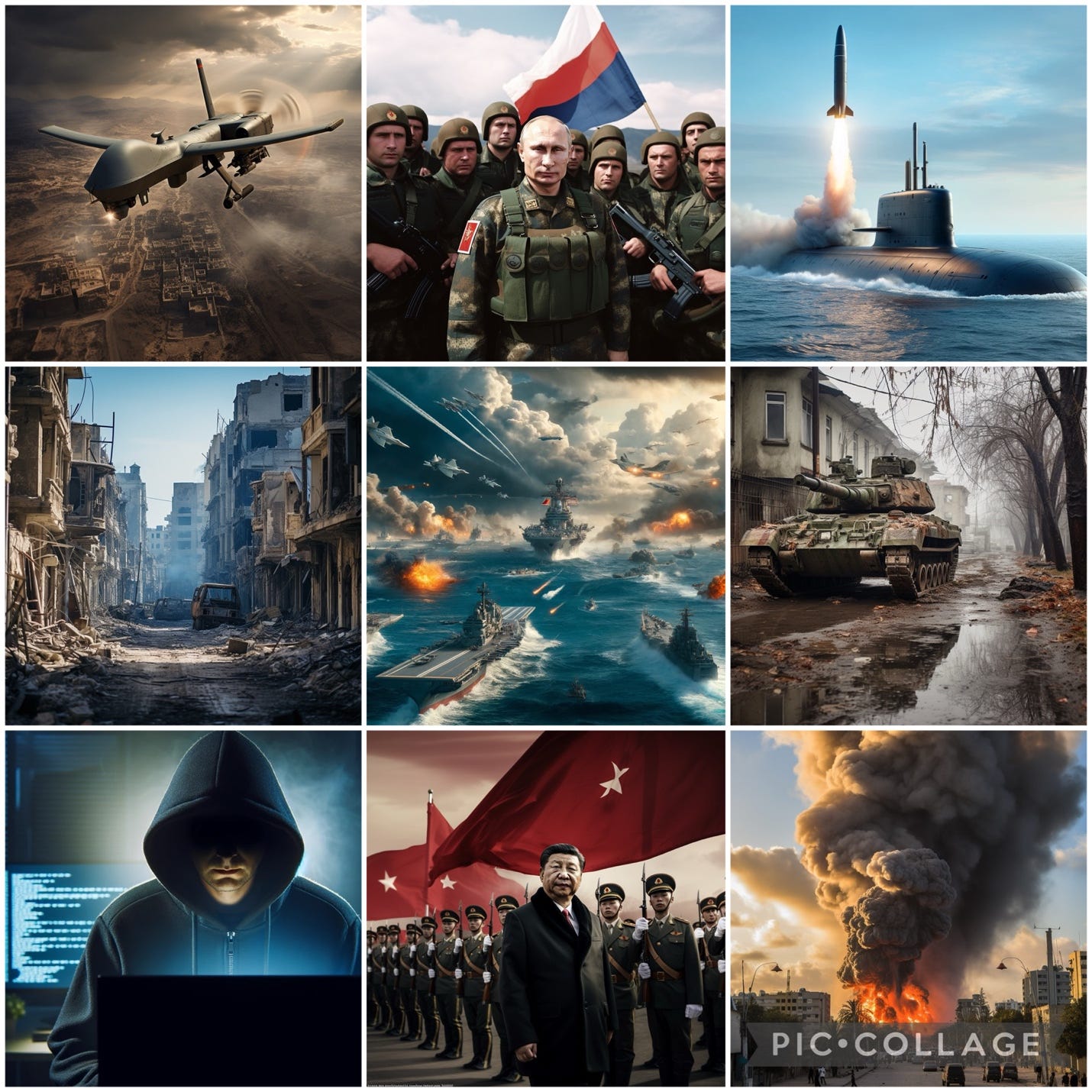Related
Key takeaways
· Imminent Conflict in Eurasia: The Battle for Eurasia is anticipated to begin within 1-4 years, with the primary focus on Taiwan. America is not prepared.
· China and Russia's War Preparations: Both China and Russia are significantly ramping up their military capabilities. China's military modernization includes a massive naval expansion and a focus on seizing Taiwan by force while Russia's war economy and conscription efforts are intensifying amid the ongoing conflict in Ukraine.
· Strategic Distractions for the US: Ongoing conflicts in Ukraine and the Middle East are straining American military resources and leadership focus. These distractions prevent the US from fully pivoting to the more critical East Asian theater, where the threat from China is growing.
· Ego-Driven Leadership and Long-Term Outlook: The personal ambitions of Xi Jinping and Vladimir Putin, who view themselves as historically significant leaders, heighten the short-term danger. Despite this, the Free World holds long-term advantages due to superior demographic, economic, and technological capabilities.
· Preventive Measures: To deter China's aggression, immediate actions such as enhancing Taiwan's defenses and settling the Ukraine conflict are crucial. Long-term efforts must focus on bolstering alliances and military readiness to ensure the Free World's stability and security in the face of rising Eurasian tensions.
This week marked the 80th anniversary of D-Day, the largest amphibious assault in world history. Only a handful of remaining centenarian WW2 veterans attended the commemorations in Normandy. In a few years, they will all be gone, just as the next cycle of human conflict risks breaking into the open.
Across the world, revisionist powers seek to disrupt the US-led world order. In Europe, the largest land war since WW2 has broken out between Russia and Ukraine. In Asia, China has stated its intention to reunify Taiwan with the mainland consistently, going back to the Communist takeover in 1949.
Though China has delayed in the past-Chinese leader Mao Zedong told Richard Nixon in 1972 that Beijing could wait 100 years to reclaim Taiwan[i]-there is reason to believe China will attempt reunification under the rule of Xi Jinping. For its part, the US and its allies, not to mention the Taiwanese, don’t want reunification and may forcibly resist Chinese efforts to subjugate the island. A war over Taiwan would be catastrophic, plunge the world into a depression, and a loss could eject the US from Asia, the most dynamic region in the world. The only way to “win” a war over Taiwan is to make sure it never happens.
In this article, I’m going to build on the ideas put forward in the Battle for Eurasia by describing the preparations of Russia and China for war, show how the wars in Ukraine and the Middle East fit into this strategy, discuss the Free World’s mobilization, consider the personalities of Vladimir Putin and Xi Jinping, and synthesize all of this into a rationale of why I think war is coming. Then, I will describe the steps America and the Free World must take to deter China and avoid war.
Axis preparations
Russia’s preparations for war have already culminated with the war in Ukraine. The Russian economy is isolated but growing, on a war footing, and producing more war material than the Free World. Putin replaced the defense minister with an economist, suggesting a long-term shift to a war economy. They are buying drones from Iran, artillery shells from North Korea, and non-lethal industrial components from China to fuel their war machine. Russia has conscripted 727,000 troops since 2022[ii] and military recruitment overall is up[iii].
China’s defense budget has increased 42x since 1991[iv], making it the second largest in the world. It has modernized its armed forces under Xi Jinping, including a significant buildup in nuclear weapons. Its navy is 27% larger US navy by number of vessels[v], has 200x the shipbuilding capacity of the US, and recently launched its third aircraft carrier. The West has no answer to China’s hypersonic weapons and the industrial potential of China is vast, comprising 29% of the world’s manufacturing capacity compared to just 17%[vi]held by the US.
Ominously, China’s central bank has begun dumping US dollar-denominated bonds, which would be subject to US sanctions in the event of war, and buying gold instead. The government is stockpiling food and other essential goods. There are even propagandistic blockbuster movies with nationalist undertones to prepare the public for war.
Spread offense
Leaders in Beijing, Moscow, and Tehran must be familiar with American football’s spread offense, which seeks to overextend the defense, making them defend more field, and exploiting any gaps and mismatches.
American support for Ukraine was supposed to “bleed Russia”, and make it a quagmire by bogging down their men, material, and money. It may have done some of those things, but it has also bled America, she has spent $175b there to date[vii], exposed a weak Western defense industrial base, and forced Russia, China, Iran, and North Korea into common cause.
The war in the Middle East has been masterminded by Iran and carried out by their proxies, who include Hamas, the Houthis, and Hezbollah. This conflict is sucking up American military resources.
Most importantly, these conflicts are taking up limited US leadership bandwidth, from elected leaders, to the military, to the security services, distracting them from the much more important, in terms of US interests, theater of East Asia. Since the Obama Administration, the US has been trying to “Pivot to Asia”. 16 years later, we’re bogged down in Eastern Europe and the Middle East.
The Free World
The US and its allies are mobilizing for war, though far too slowly.
In Europe, the NATO alliance has expanded and its populations are slowly waking up to its shoddy defensive capabilities. In Europe and America, combined arms production is slowly ramping up and its industrial potential is vast, if yet underutilized.
In Asia, a network of anti-China alliances, led by the US, are growing, including the Quad, AUKUS, and American, Japanese, and South Korean trilateral pact. The US is expanding its Pacific footprint and the countries in the region are rearming. The US is supplying weapons to Taiwan, though they are years late and vastly outnumbered by those going to Ukraine ($175b)[viii] and Israel ($13b)[ix].
Ego
Both Vladimir Putin and Xi Jinping think they are historically important rulers in their nation’s histories, and will not be content to simply run out the clock.
Vladimir Putin views himself akin to Tsar Peter the Great, the 17th-century ruler who grew the area of the Russian empire by 93%[x] during his reign. Likewise, he views the collapse of the Soviet Union as a great tragedy and draws his legitimacy as a ruler from rebuilding Russia during his tenure from 2000 to present.
Xi Jinping likens himself to Mao Zedong, the revolutionary leader of Communist China from 1949 until his death in 1976. Xi has abolished the traditional two term limit observed by all leaders since Mao and has conducted extensive purges, consolidating his control. He has instructed the armed forces to be able to seize Taiwan by 2027 and has repeatedly stated his desire to reunify China and Taiwan in his lifetime.
Countdown to war
Combine all of these factors and it is my working hypothesis that China will attempt to seize Taiwan in the next 1-4 years, possibly during a US Presidential transition or during the Olympics, while the world is distracted. Both China and Russia are rapidly rearming and have repeatedly stated their desire to revise the US-led world order. Wars in Ukraine and the Middle East should not be viewed as isolated but rather as ways to overextend and deplete US military power across the Eurasian chessboard. The longer that Xi waits to invade Taiwan, the stronger the anti-China alliance becomes. The Free World faces short-term maximum danger before they can mobilize, which China and Russia understand. And both Putin and Xi have self-images as world historical figures, unlikely to leave conquest to their successors.
Preventing war: the porcupine strategy
War is not inevitable and the Free World can deter China from seizing Taiwan.
First, underlying all preparation should be the principal that time is of the essence and we must move forward with the military we have, not the military we want. Long-term efforts like redesigning the force posture, streamlining alliance networks, developing and deploying advanced weapons systems, and transforming the defense industrial base are great objectives. They should all be pursued, but won’t be ready in time to deter the Battle for Eurasia and should be pursued in parallel to achievable, if messy, short-term improvisations.
Second, efforts should be pursued, even if territorial concessions must be made, to settle the war in Ukraine. This will likely be on unfavorable terms, but the US’s focus on Asia is more important.
Finally, Taiwan should be made into a porcupine impossible for China to seize without bearing excessive cost. This means sending additional defensive military aid to Taiwan, focusing on weapons that make the island indigestible. The best way to win a war over Taiwan is to never fight one.
China and Russia both face significant long-term demographic headwinds. The Free World is well positioned over the rest of the century. Over the long run, we win, but we face maximum danger over the next 1-4 years.
The looming threat of conflict in Eurasia, particularly over Taiwan, poses a significant challenge to global stability. The US and its allies must urgently enhance their readiness and deter aggression through strategic mobilization and robust alliances. Settling existing conflicts, such as the war in Ukraine, and fortifying Taiwan's defenses are crucial steps to avoid a catastrophic war. The Free World's long-term advantage lies in its superior demographic, economic and technological capabilities, but urgent actions are essential to navigate the next 1-4 years.
[i] https://foreignpolicy.com/2023/09/08/us-military-deterrence-china-taiwan-war-east-asia/
[ii] https://www.perplexity.ai/search/How-many-troops-86bsdPXaQ4WNjVrDXsRNlg
[iii] https://www.perplexity.ai/search/How-many-troops-86bsdPXaQ4WNjVrDXsRNlg
[v] https://news.usni.org/2024/02/01/report-to-congress-on-chinese-naval-modernization-20
[vi] https://www.statista.com/chart/20858/top-10-countries-by-share-of-global-manufacturing-output/
[vii] https://www.cfr.org/article/how-much-us-aid-going-ukraine
[viii] https://www.cfr.org/article/how-much-us-aid-going-ukraine
[ix] https://www.cfr.org/article/us-aid-israel-four-charts
[x] https://www.perplexity.ai/search/How-much-did-boddiyRpSG.eQh7cOSgZfg








